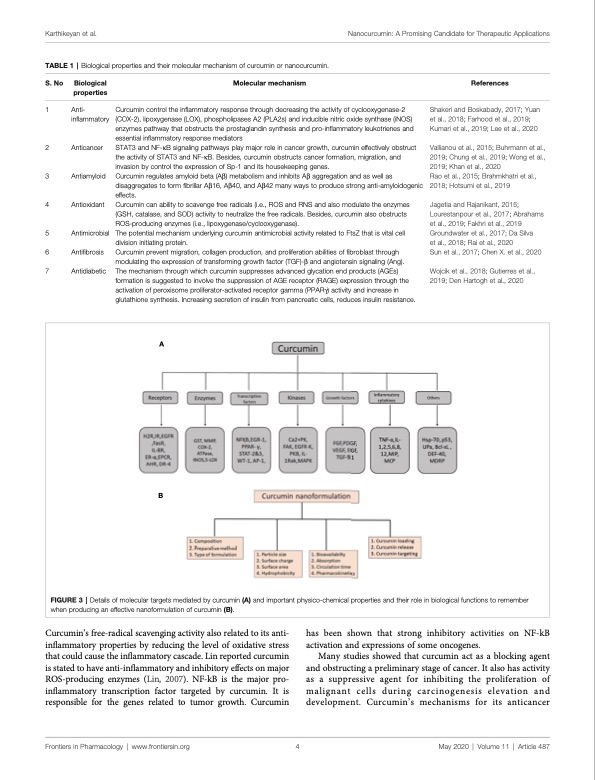
PDF Publication Title:
Text from PDF Page: 004
Karthikeyan et al. Nanocurcumin: A Promising Candidate for Therapeutic Applications TABLE 1 | Biological properties and their molecular mechanism of curcumin or nanocurcumin. S. No 1 2 3 4 5 6 7 Biological properties Anti- inflammatory Anticancer Antiamyloid Antioxidant Antimicrobial Antifibrosis Antidiabetic Molecular mechanism Curcumin control the inflammatory response through decreasing the activity of cyclooxygenase-2 (COX-2), lipoxygenase (LOX), phospholipases A2 (PLA2s) and inducible nitric oxide synthase (iNOS) enzymes pathway that obstructs the prostaglandin synthesis and pro-inflammatory leukotrienes and essential inflammatory response mediators STAT3 and NF-kB signaling pathways play major role in cancer growth, curcumin effectively obstruct the activity of STAT3 and NF-kB. Besides, curcumin obstructs cancer formation, migration, and invasion by control the expression of Sp-1 and its housekeeping genes. Curcumin regulates amyloid beta (Ab) metabolism and inhibits Ab aggregation and as well as disaggregates to form fibrillar Ab16, Ab40, and Ab42 many ways to produce strong anti‐amyloidogenic effects. Curcumin can ability to scavenge free radicals (i.e., ROS and RNS and also modulate the enzymes (GSH, catalase, and SOD) activity to neutralize the free radicals. Besides, curcumin also obstructs ROS-producing enzymes (i.e., lipoxygenase/cyclooxygenase). The potential mechanism underlying curcumin antimicrobial activity related to FtsZ that is vital cell division initiating protein. Curcumin prevent migration, collagen production, and proliferation abilities of fibroblast through modulating the expression of transforming growth factor (TGF)-b and angiotensin signaling (Ang). The mechanism through which curcumin suppresses advanced glycation end products (AGEs) formation is suggested to involve the suppression of AGE receptor (RAGE) expression through the activation of peroxisome proliferator-activated receptor gamma (PPARg) activity and increase in glutathione synthesis. Increasing secretion of insulin from pancreatic cells, reduces insulin resistance. References Shakeri and Boskabady, 2017; Yuan et al., 2018; Farhood et al., 2019; Kumari et al., 2019; Lee et al., 2020 Vallianou et al., 2015; Buhrmann et al., 2019; Chung et al., 2019; Wong et al., 2019; Khan et al., 2020 Rao et al., 2015; Brahmkhatri et al., 2018; Hotsumi et al., 2019 Jagetia and Rajanikant, 2015; Lourestanpour et al., 2017; Abrahams et al., 2019; Fakhri et al., 2019 Groundwater et al., 2017; Da Silva et al., 2018; Rai et al., 2020 Sun et al., 2017; Chen X. et al., 2020 Wojcik et al., 2018; Gutierres et al., 2019; Den Hartogh et al., 2020 A B FIGURE 3 | Details of molecular targets mediated by curcumin (A) and important physico-chemical properties and their role in biological functions to remember when producing an effective nanoformulation of curcumin (B). Curcumin’s free-radical scavenging activity also related to its anti- inflammatory properties by reducing the level of oxidative stress that could cause the inflammatory cascade. Lin reported curcumin is stated to have anti‐inflammatory and inhibitory effects on major ROS‐producing enzymes (Lin, 2007). NF‐kB is the major pro- inflammatory transcription factor targeted by curcumin. It is responsible for the genes related to tumor growth. Curcumin has been shown that strong inhibitory activities on NF‐kB activation and expressions of some oncogenes. Many studies showed that curcumin act as a blocking agent and obstructing a preliminary stage of cancer. It also has activity as a suppressive agent for inhibiting the proliferation of malignant cells during carcinogenesis elevation and development. Curcumin’s mechanisms for its anticancer Frontiers in Pharmacology | www.frontiersin.org 4 May 2020 | Volume 11 | Article 487PDF Image | Nanocurcumin Promising Candidate for Therapeutic Applications

PDF Search Title:
Nanocurcumin Promising Candidate for Therapeutic ApplicationsOriginal File Name Searched:
fphar-11-00487.pdfDIY PDF Search: Google It | Yahoo | Bing
CO2 Organic Rankine Cycle Experimenter Platform The supercritical CO2 phase change system is both a heat pump and organic rankine cycle which can be used for those purposes and as a supercritical extractor for advanced subcritical and supercritical extraction technology. Uses include producing nanoparticles, precious metal CO2 extraction, lithium battery recycling, and other applications... More Info
Heat Pumps CO2 ORC Heat Pump System Platform More Info
| CONTACT TEL: 608-238-6001 Email: greg@infinityturbine.com | RSS | AMP |